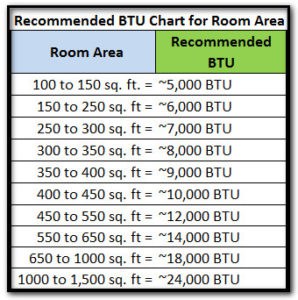Heater Guide
- Space Heater Types
- Heaters by Room or Area
- Watts, Volts and BTU’s
- Heater Safety Tips
- Energy Efficiency Tips
- Types of Heat – Radiant / Convection
- Calculate Your Heater Size
Space Heater Types
The variety of space heaters available makes it helpful to be familiar with the various types on the market before choosing the heater for your room or area. Once you decide on the type of space heater you can then calculate your heater size to get the one that will perform most efficiently. These heaters are described in more detail on the linked pages.
Ceramic Space Heaters are radiant heaters costing substantially less than electrical or oil/gas house heating systems with room by room control. Electricity passing through ceramic plates heats the plates. Aluminum baffles absorb the heat and radiate to the area desired. Some may have fans to blow the heated air into the room.
Oil-Filled Space Heaters are lightweight, wheel mounted for easy transport between rooms and look somewhat like standard steam or hot-water radiators. They are permanently filled with oil that is heated by electricity and which is much more efficient than water in supplying radiant heat to an area.
Wall Mounted Heaters are permanently attached to a wall in rooms where heat is not required all of the time – such as for guestrooms or spare bathrooms. Electrically operated, these heaters can be ordered to supply radiant, convection or both types of heat to the area. They can be mounted on the surface of the wall or recessed between studs.
Infrared space heaters produce radiant heating provided by common types of space heaters. These heaters use glowing quartz or some other types of metallic element and reflectors to quickly provide heat to a specific area close to the heater rather than to an entire room. However there are types of heaters that are able to provide a wider range or heating area depended on its BTU.
Vortex heaters use a technology developed by Vornado using vortex action to circulate heated air throughout the room. Occupants are surrounded by a blanket of warmth rather than being either in or out of the warm airflow.
Oscillating heaters use reflected radiant heat, not a fan, to warm the people and objects in front of them. Oscillation provides warmth to a wider area without blowing dust around.
Baseboard heaters typically are permanently installed, although portable models are available. They are similar in appearance to hot water baseboard heating. Heating is provided by electricity and convection currents to move warmed air into the room. Like wall-mounted heaters, these are often used in spaces where heat is not required all the time.
Heaters by Room or Area
As you consider the purchase of a space heater you’ll need to consider the rooms or areas where it will be used and how it will be used.
Space heaters can be used
- as a supplement to existing heating such as central steam, hot water or forced hot air systems
- as a substitute for central heating in rooms seldom used in order to help prevent dampness and mildew from developing
- to provide temporary heat for guest rooms or spare bathrooms
- to heat the “home office” for telecommuters or the self-employed without having to turn up the thermostat for all living areas
- to warm outside areas such as patios, pool decks and porches when evenings turn too cool
- to provide “on demand” heating in garages, cellars and workrooms.
Space heaters used as a supplement to existing heating find application in bedrooms when occupants want to be comfortable and the same time turn down the household thermostat. Generally convection heaters make more sense in this application because the objective is to warm the entire area rather than a specific location which is better suited by radiant heaters. Baseboard, wall mount and vortex heaters are typically employed for supplemental heat in bedrooms.
Rooms where occupants spend more time than sleeping may also benefit from radiant space heaters that direct warmth to people or objects.
Family rooms – typically recreation rooms in basements or otherwise removed from general living areas – benefit from convection space heaters when used occasionally for family get-togethers or neighborhood parties. Also suitable are fan-equipped ceramic, vortex and oscillating radiant heaters that are designed for larger areas.
Regardless of the room or area size it is important to calculate your heater size in order to provide the heating needed at the most energy efficiency.
Space heaters are available for patios and garages. Patio heaters are powered bypropane or electricity and are designed to extend the use of your outdoor facilities by providing needed warmth in early spring or late fall. Depending on the source of power they can be portable, free standing, mounted on walls or ceilings or even placed on thetabletop. Garage units can be wall mounted or baseboard to provide a comfortable environment on an occasional basis.
As with all instances, it is important to calculate your heater size and be familiar with the various space heater types before making a decision.
Volts, Watts, BTUs and Amps
Terms commonly associated with space heaters are volts, watts, BTUs and amps. Understanding what these terms mean will be helpful to calculate your heater size.
Volts are difficult to define, but can be thought of as a measure of electrical current flow. The higher the voltage, the more current will flow. In North America most household electrical current powering the TV, radio, lighting and appliances, for example, operates at 110-120 volts. Heavy-duty appliances such as electric ranges, clothes dryers and high-capacity air conditioners may require 220 volts.
Most electric space heaters are designed and labeled to operate at 110-115 volts, and are plugged into a standard electrical wall outlet.
The watt is the measure of energy conversion. The amount of watts consumed is reported on your electric bill. Think of a light bulb – the higher the wattage the brighter the light. The wattage delivered by space heaters relates directly to the amount of heat it can deliver. Some space heaters provide a choice, such as 750 or 1500 watts.
The BTU as defined by wisegeek.com is short for British Thermal Unit, a basic measure of thermal (heat) energy. When looking at space heaters keep in mind that even the smallest units can produce 10,000 BTUs or more. Therefore BTU numbers should primarily be used as a comparison between systems. Larger and more expensive systems should provide significantly higher BTUs than smaller ones. When deciding between similarly priced units, compare the BTUs for a better gauge of performance.

Amperage, also called current, is the amount of electrical energy flowing through a space heater or any other appliance at any given time. This measurement is often shortened to amps. Amps are also used to rate household circuit breaker panels. Most new houses are equipped with 100- or 200-amp panels. Amps also rate individual circuit breakers within the panels – 15 to 30 amps are the most common today.
If you connect too many appliances or an appliance that requires 25 amps to a 15-amp circuit, the breaker will trip – as it would if you plugged in a faulty lamp or otherwise caused a short circuit. Without being protected by circuit breakers electrical wires could become overloaded, heat up and cause a fire. Note that the solution to a constantly tripping circuit breaker is not installing one rated at higher amps. This could cause inadequate household wiring to overheat.
Heater Safety Tips
Tom Kovach wrote on Space Heater Safety Tips in Backwoods Home Magazine*. Following are some excerpts.
If you are going to try to take the chill out of your home without turning on your main sources of heat,…., space heaters are designed for just that purpose. Here are some tips on the safe selection and use of space heaters:
- Make sure the space heater has been tested to the latest standards and is certified by a nationally recognized testing laboratory such as Underwriters Laboratories (UL).
- Make sure the heater has an automatic “tip-switch,” a cutoff device (now required) that turns off electric or kerosene heaters if they tip over.
- Make sure it has a guard around the flame area or heating element.
If you are choosing an electric space heater, keep in mind these important items:
- Place the heater on a level, hard, nonflammable surface; do not place on rugs or carpets, near bedding or drapes, or on tables or countertops.
- Keep the heater at least 3 feet from bedding, drapes, furniture or other flammable items.
- Turn the space heater off if you leave the area, and never leave a space heater on while sleeping or if you leave home.
- Keep children and pets away from space heaters.
- Do not use older space heaters or heaters with cords that are cracked or frayed.
In recent years some manufacturers and Consumer Product Safety Commissions have recalled some space heaters. Check out this list at: http://www/cpsc.gov.
If you decide to use a combustion-fuel heater (gas, propane, etc.) there are some important things to remember. They are:
- Do not use heaters that vent their exhaust into the room. They are referred to as unvented space heaters and can cause carbon monoxide to be released. Although an oxygen depletion alarm is standard with most of these heaters, these are not the same as carbon monoxide alarms. “Room-vented” space heaters that are wall-mounted and connected to gas lines are also “unvented” space heaters.
- Combustion fuel space heaters need to be professionally installed to vent all exhaust products outside the home. They should also be cleaned and tuned on a regular basis. And as with furnaces, this should be done by a professional.
Unvented space heaters that use a combustion fuel such as kerosene, propane, or natural gas are not recommended for use in homes, including mobile homes.
(*http://www.backwoodshome.com /articles2/kovach90.html)
Energy Efficiency Tips
(Sources for the following include the US Department of Energy’s energysvers.gov website)
Space Heaters

Space heater capacities are measured in British Thermal Units (BTUs) and generally range between 10,000 BTU to 40,000 BTU per hour. Portable space heaters used in the home are most commonly electrically powered. Propane or other sources of heat can be used for units used in outside areas such as patios.
To get the most energy efficiency out of your space heater you should first determine which type of heat you prefer. Convection heaters are often selected when you want to heat a larger area occupied by several people. Radiant heaters transfer the heat to individuals or objects when it is not necessary to heat an entire area.
Once you have decided to invest in a space heater the next step is to calculate your heater size. Several factors apply to help you get the most energy efficiency from the heater selected. These include the size of the room in cubic feet, the quality of your building’s insulation, number of windows, your geographic location and whether the heater is the only or an additional source of warmth. Then you can select from the various sizes and models of space heater types available.
A Note on Combustion Space Heaters…
Space heaters are classified as vented and unvented, or “vent free.” Unvented combustion units are not recommended for use inside your home, as they introduce unwanted combustion products into the living space, including nitrogen oxides, carbon monoxide, and water vapor. The units also deplete the air in the space where they are located. Most states have banned unvented kerosene heaters for use in the home and at least five have banned the use of unvented natural gas heaters.
……versus Electric Space Heaters
While electric space heaters can be more expensive to operate than combustion space heaters they are the only unvented space heaters that are safe to operate inside your home. Although they avoid indoor air quality concerns, they still carry hazards of potential burns and fires. Users should be familiar with and follow heater safety tips.
(Ref.: energysavers.gov)
Types of Heat – Radiant / Convection
Understanding the difference between radiant heat and convection heat is easy. Go outside on a warm sunny day and stand in the direct sunlight. The heat you feel is radiant heat – it is warming you. Then step into the shade of a tree. The heat you feel is convection heating from the sun-warmed air.
The US Department of Energy website describes radiant heating systems as depending largely on radiant heat transfer: delivering warmth directly from a hot surface to people and objects in the room by the radiation of heat. Another way of describing it is infrared radiation. Radiant heating is the effect you feel when you can feel the warmth of a hot stovetop element from across the room or warmth from a portable infrared heater.
As the primary source of residential heating, radiant heating is more efficient than baseboard (convection) heating and usually more efficient than forced-air central heating because no energy is lost through ducts. The lack of moving air can also be advantageous to people with allergies.
As a primary heating source radiant heaters can be expensive to operate. But they can provide supplemental heating in some rooms or can provide heat to a home addition when extending the central heating system is impractical.
Radiant space heaters have the advantage of quick response time. If rooms are not always occupied this can potentially result in cost and energy savings. People entering a room can turn on the space heater and reach a comfortable level within minutes.
Finally, radiant space heaters operate on a line-of-sight basis: you’ll be most comfortable if you’re close to the heater.
A point to keep in mind is that convection space heaters are safer for families with children and pets because there is less danger of burns than with radiant heaters and fireplaces.
It is important to calculate your heater size when selecting between radiant infrared and convection space heaters. Getting the most energy efficiency is another consideration.
Space heaters should be sized to the area being heated and how often they will be employed to warm the space.
——————–
The US Department of Energy website
Calculate Your Heater Size
Several factors must be considered when determining the size of a space heater – that is how much heat it should produce. As noted in Volts, Watts, BTUs and Amps BTU numbers are used as a comparison between systems. Larger and more expensive systems should provide significantly higher BTUs than smaller ones but when deciding between similarly priced units, compare the BTUs for a better gauge of performance.
The question then becomes “How many BTUs do I need?” As you might expect, several variables apply. These include where you are located geographically, using the space heater the main or supplemental source of heat, the volume of the room in cubic feet, the efficacy of the insulation, number and size of windows, presence of an open stairway and the temperature desired. Some heater manufacturers provide a chart or size guideline to assist in making the determination.
Before you go shopping you can get an idea of the size of heater you need by using one or more of the online BTU calculators.
Southampton, MA – based CHI Associates, creators of Hearth.com as an independent hearth website, offers an online BTU calculator found at http://hearth.com/calc/btucalc.html. It suggests that an average-insulated room that is 10 x 12 x 8-feet high in a cold climate would require a maximum of 3840 and minimum of 1920 BTUs to heat the area in most weather. Industrial portable heater supplier Herman Nelson International offers another calculator resource. It is found at http://www.herman-nelson.com/btu_calculator.cfm.
Once you’ve determined the size of space heater needed in terms of BTUs you can comparison shop for the best price based on the many available space heater types.
But in comparing various heaters having similar BTU ratings do not ignore the products’ requirements as described in Volts, Watts, BTUs and Amps to be certain that it will be safely and sufficiently powered when you plug it in. If the heater requires more power than your room outlets are safely capable of providing an alternative is to procure two smaller units powered by separate circuit breakers. Note that using an extension cord running from outlets in an adjacent room does not solve this situation, as extension cords should never be used with space heaters. The preferred solution is hiring an electrical contractor to install a separate circuit to the room. Please see our heater safety tips for other guidelines.

